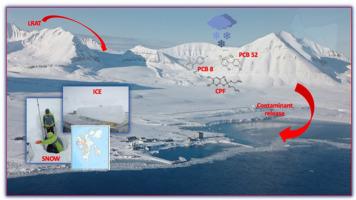斯瓦尔巴群岛斯匹次卑尔根冰冻圈遗留污染物的空间分布、时间趋势和环境命运。
IF 7.7
2区 环境科学与生态学
Q1 ENVIRONMENTAL SCIENCES
引用次数: 0
摘要
北极冰冻圈,特别是斯瓦尔巴群岛的冰川,既是一个储存库,也是一个通过远距离大气途径输送的持久性有机污染物(POPs)污染的指标。本研究对季节性雪和浅冰芯中的多氯联苯(PCBs)、遗留农药(LPs)和当前使用农药(CUPs)进行了全面分析。在连续两次春季运动(2022-2023年)期间,从三个斯匹次卑尔根冰川(Austre Brøggerbreen, Midtre lovsamunbreen和Kongsvegen)收集了样本。多氯联苯在污染物中占主导地位,在地表雪中发现的贡献最大。低氯同系物如PCB8和PCB52最为普遍,反映了冷气候的运输和沉积动力学。LPs表现出更大的变异性,在冰芯中显示出更高的浓度(平均92.2±50.9 pg/L),表明在雪变质和融水渗透过程中存在持续性和优先保留。相比之下,CUPs在雪中更为丰富(平均120±73.6 pg/L),突出了它们的季节性淋滤潜力。虽然总污染物浓度没有明显的年际差异,但空间变异性突出了冰川地形和暴露于大气源的影响。最后,我们将地表质量平衡数据与我们的分析结果结合起来,提供了在被调查的冰川地点冰雪融化中每年释放的多氯联苯、LPs和CUPs污染物的估计。尽管空间代表性有限,但我们的研究结果揭示了气候变化和冰川消融如何重新调动这些遗留污染物,对北极生态系统构成未充分调查的风险。这些发现强调迫切需要更有针对性的采样和监测,以便更深入地了解极地地区的持续污染。本文章由计算机程序翻译,如有差异,请以英文原文为准。

Spatial distribution, temporal trends, and environmental fate of legacy contaminants in the cryosphere of Spitsbergen, Svalbard Islands
The Arctic cryosphere, particularly the glaciers of the Svalbard Archipelago, serves as both a repository and an indicator of persistent organic pollutants (POPs) contamination transported via long-range atmospheric pathways. This study provides a comprehensive analysis of polychlorinated biphenyls (PCBs), legacy pesticides (LPs), and current-use pesticides (CUPs) in seasonal snow and shallow ice cores. Samples were collected from three Spitsbergen glaciers (Austre Brøggerbreen, Midtre Lovénbreen, and Kongsvegen) during two consecutive spring campaigns (2022–2023). PCBs dominated the contaminant profile, with the highest contributions found in surface snow. Low-chlorinated congeners, such as PCB8 and PCB52, were the most prevalent, reflecting cold-climate transport and deposition dynamics. LPs exhibited greater variability, showing higher concentrations in ice cores (mean 92.2 ± 50.9 pg/L), suggesting persistence and preferential retention during snow metamorphism and meltwater infiltration. In contrast, CUPs were more abundant in snow (mean 120 ± 73.6 pg/L), highlighting their potential for seasonal leaching. While total contaminant concentrations revealed no significant interannual differences, spatial variability highlighted the influence of glacier topography and exposure to atmospheric sources. Finally, we combined surface mass balance data with our analytical results to provide an estimate of the annual contaminant release of PCBs, LPs, and CUPs from snow and ice melt at the investigated glacial sites. Despite limited spatial representation, our findings reveal how climate change and deglaciation could remobilize these legacy contaminants, posing under-investigated risks to the Arctic ecosystem. These findings emphasize the urgent need for more targeted sampling and monitoring for a deeper understanding of persistent pollution in polar regions.
求助全文
通过发布文献求助,成功后即可免费获取论文全文。
去求助
来源期刊

Environmental Research
环境科学-公共卫生、环境卫生与职业卫生
CiteScore
12.60
自引率
8.40%
发文量
2480
审稿时长
4.7 months
期刊介绍:
The Environmental Research journal presents a broad range of interdisciplinary research, focused on addressing worldwide environmental concerns and featuring innovative findings. Our publication strives to explore relevant anthropogenic issues across various environmental sectors, showcasing practical applications in real-life settings.
 求助内容:
求助内容: 应助结果提醒方式:
应助结果提醒方式:


